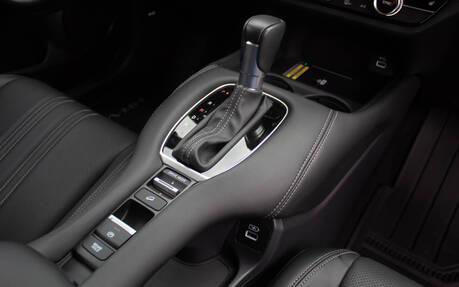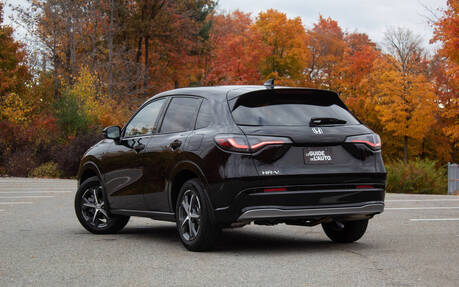2023 Honda HR-V: Bigger But Not Roomier
The Honda HR-V has been around in North America since the spring of 2015, helping the Japanese automaker enter the now extremely popular sub-compact crossover segment. Since then, it’s managed to attract many customers while warding off threats from new players such as the Nissan Kicks, Chevrolet Trailblazer, Hyundai Kona and Kia Seltos.
As the third best-selling Honda in Canada, trailing only the CR-V and Civic, the HR-V received a complete redesign for the 2023 model year. It’s not quite as round and tiny as its predecessor, but more importantly, it’s heavier, brawnier and, well, pricier.
- Also: 2023 Honda HR-V: Improved But Not Groundbreaking
- Also: Next-Gen 2023 Honda HR-V Looks More Rugged, Packs More Power
You can see the same thing happening across the industry, mind you. At Chevrolet, the all-new 2024 Trax is larger than the original. Mazda, meanwhile, has effectively replaced the diminutive CX-3 with the CX-30. Similar to the latest HR-V, these models are blurring the lines in the segment and making the decision more difficult for shoppers.
Longer and Wider
The 2023 Honda HR-V is 220 mm longer, 68 mm wider and 15 mm taller than the previous generation, while the wheelbase has been stretched 45 mm. You’d think the interior is much roomier as a result, but that’s not the case.
Once again, the base LX model is available with FWD or AWD, the latter requiring a premium of $2,300. It’s definitely something you should consider if you regularly face more challenging road and weather conditions. The Sport and EX-L Navi models come standard with AWD and, of course, a lot more content.
All HR-Vs ride on 17-inch alloy wheels and a MacPherson strut front suspension. The rear suspension now consists of a multi-link setup instead of a torsion beam, improviving handling and ride quality.

Nice Tech, Disappointing Rear Seats
The interior is dramatically revamped, as well. Forget the small 5- or 7-inch display that was buried in the dashboard of the old HR-V. It’s been replaced by a free-standing, 7- or 9-inch touchscreen atop the redesigned, Civic-like dashboard, complete with a horizontal mesh grille that conceals the air vents in a pretty sleek and effective way.

The front seats are spacious and accommodating, but the rear bench fails to impress. In fact, 40 mm of legroom are gone. Trunk capacity with the rear seatbacks up is basically the same as before, and the convenient load floor makes packing stuff a breeze.
In case you haven’t heard, the HR-V’s signature Magic Seat is no more. What a shame. With the ability to flip up the seat cushions, that marvel of car seat design really came in handy when you needed to haul large items.
More Powerful Engine
Providing extra motivation to the small, Mexican-built crossover is a new, naturally aspirated 2.0-litre four-cylinder engine borrowed from the Civic LX, EX and Sport. Rated at 158 hp and 138 lb-ft. of torque (an increase of 17 hp and 11 lb-ft. over the departed 1.8-litre mill), it teams up with a continuously variable transmission on all models.

There are three drive modes to choose from: Econ (efficient but boring), Normal (just fine) and Sport (a bit more responsive, but the higher revs make the engine louder). Hill start assist is included, as well.
Despite the gain in power and torque, the new 2023 Honda HR-V is by no means a rocket. For one thing, it’s about 5-9 percent heavier. Sprints from 0-100 km/h are a matter of 10 seconds, give or take a few tenths, so nothing has changed here. Obviously, this is a family-oriented vehicle, not a sports car like the S2000 roadster we miss so much.
Overall, linear acceleration and smart CVT mapping make for pleasant if not exciting operation in daily driving conditions.
Poor Fuel Economy, High Prices
Driving the smallest crossover in the Honda lineup doesn’t mean you’ll save the most on gas. The 2023 HR-V achieves a combined 8.3 L/100 km in FWD configuration and 8.7 L/100 km in AWD configuration. Both are up 6 percent from the 2022 model’s figures.

Ironically, the larger and heavier 2023 CR-V is more fuel-efficient with ratings of 7.8 L/100 km and 8.4 L/100 km, respectively. In addition, it offers something the HR-V doesn’t—an available hybrid powertrain (6.4 L/100 km)—though only in top-line Touring trim starting at nearly $50,000.
The point with any small crossover is to offer low prices in order to attract young customers. However, the 2023 Honda HR-V’s prices have gone up $2,530 in LX FWD and LX AWD trim, and $2,430 in Sport and EX-L trim. Freight and PDI now cost $130 extra. A gas-electric HR-V would arguably be way too expensive.
Just to be clear, the popular Hyundai Kona, Kia Seltos and many more currently undercut the HR-V by a wide margin.

Bottom Line
The 2023 Honda HR-V boasts modern styling and pleasant driving dynamics. However, the high prices versus the competition are almost a deal-breaker. What used to be a cheap and practical little crossover doesn’t look like such a good buy anymore. Is Honda’s reputation enough to justify the larger monthly payments? You decide.
| Test drive report | |
| Test model | 2023 Honda HR-V |
|---|---|
| Trim level | EX-L Navi TI |
| Price range | $28,730 – $37,130 |
| Price as tested | 37 130 $ |
| Warranty (basic) | 3 years/60,000 km |
| Warranty (powertrain) | 5 years/100,000 km |
| Fuel economy (city/highway/observed) | 9,4 / 7,8 / N/A L/100km |
| Options | N/A |
| Competitive models | 2024 Hyundai Kona, 2023 Mazda CX-30, 2024 Kia Seltos, 2023 Toyota Corolla Cross, 2023 Nissan Qashqai, 2023 Jeep Compass, 2024 Subaru Crosstrek, 2023 Volkswagen Taos, 2023 Mitsubishi RVR |
| Strong points | N/A |
| Weak points | N/A |
